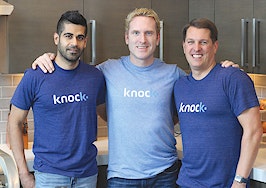In a presentation at Inman Connect, real estate consultant Michael DelPrete said Opendoor‘s “nightmare scenario” is 160,000 Keller Williams agents “in people’s living rooms and kitchens waving around an iBuyer brochure and saying, ‘We do that, too.”
His point is that Opendoor, a tech-powered homebuying and selling startup with $1 billion in venture capital, is vulnerable to competition from companies that already connect with consumers on a massive scale at the beginning of their home-buying or selling journey.
Other threats to iBuyers in general include human risk aversion and the possibility that consumers will make a habit of pitting iBuyers against each other, DelPrete said.
Opendoor has to spend considerable cash on advertising to coax homeowners into asking for offers from the iBuyer, but a number of other players who are entering the space, or are thinking about doing so, do not.
Zillow, for example, is prompting homeowners to request an offer on all Zillow.com property pages covering Phoenix, those for both for-sale and off-market homes.
“This costs Zillow approximately zero dollars,” DelPrete said.
As of November, only seven months after the launch of Zillow’s iBuyer, Zillow had already received offer requests from 20,000 homeowners. So perhaps it should come as no surprise that Zillow has ramped up its purchases rapidly. DelPrete said the industry giant is obviously going “all-in” with the iBuyer business, and that the operation could potentially generate $1 billion in annual revenue for the firm.
Keller Williams also has a massive, ready-made distribution network — its hordes of agents — to shower homeowners with offers from its future in-house iBuyer, which the franchisor said it plans to launch soon.
Not only could that undermine Opendoor’s value proposition, it could create a “a lot of customer confusion” in the iBuyer space, DelPrete said.
It’s worth noting, however, that Keller Williams agents may also advise iBuyer-curious clients to sell their homes to Opendoor, not necessarily just to Keller Williams’ in-house iBuyer. Some are already doing that, and if they have their customers’ best interests at hearts, they will recommend the best iBuyer offer, not just the one available from Keller Williams’s iBuyer.
Human psychology represents another obstacle for Opendoor — as well as to other iBuyers.
“The pain that humans experience for a loss is greater than the corresponding pleasure they get from a gain,” DelPrete said, pointing to what he said are mounds of research corroborating this concept.
The growth of Netflix, Uber and Airbnb show that consumers are ready to take low-stakes risks with services.
But whereas those companies provide services that, to varying degrees, involve low value and frequent transactions, iBuyers provide just about the most high-value and infrequent transaction there is: buying or selling a house. It puts “their safety and their family and their shelter” on the line, he noted.
Another danger is that consumers will make a habit of requesting offers from all iBuyers in their local market, playing these capital-intensive startups off each other and squeezing their margins.
Those margins are already much thinner than critics who dismiss iBuyers as low-ballers might have you believe. (DelPrete said the frequent accusation that iBuyers make lowball offers is “false.”)
The difference between the price that Opendoor and Zillow buy a home for and then sell the same home for averages about 5 percent, according to data collected by DelPrete. Offerpad’s is closer to seven percent, he said.








